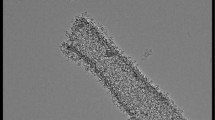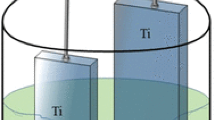Abstract
Titanium dioxide (TiO2) nanotubes have attracted much attention due to their formation, properties, and functionality in recent years. Many methods have been used to obtain the nanotubes, such as template synthesis, hydrothermal, sol–gel, and electrochemical anodization. Compared to others, the electrochemical anodization method makes it possible to grow dense and well-aligned nanotube layers on pure and/or alloyed titanium surfaces. However, for enhanced photocatalytic activities, the parameters of the anodization process such as applied potential, time, and electrolyte composition should be tightly controlled to obtain regular, well-aligned, and continuous nanotube arrays. Alternatively, by the formation of heterojunctions such as α-Fe2O3/TiO2, the performances of the photocatalysts can be boosted due to the shifts of absorption range into the visible region and narrower band gaps of the hierarchical structures. In this study, TiO2 nanotubes were obtained by electrochemical anodization on Ti foil in ethylene glycol, ammonium fluoride and distilled water-based electrolyte under constant voltage and varying anodization durations. Herein, it was aimed to observe the effects of the anodization time on the length and diameter of the nanotubes, which have significant roles on the photocatalytic activity. Besides the investigation of the anodization parameters, the heterogeneous structure, α-Fe2O3/TiO2, was formed on anodized surfaces to scrutinize the improvement of the photocatalytic properties. The TiO2 nanotubes were characterized through XRD and SEM to determine the phase structure and morphology, respectively. The variation of optical bandgap values of α-Fe2O3/TiO2 samples depending on the processing parameters was determined by using a UV–Vis spectrophotometer. The photocatalytic performances of the α-Fe2O3/TiO2 photocatalysts were revealed using an aqueous solution of methylene blue. Photocatalytic degradation rates and kinetic study of α-Fe2O3/TiO2 photocatalysts were evaluated by a comparative approach. The highest degradation efficiency was achieved as 85% using the α-Fe2O3 coated photocatalyst with the anodization time of 30 min and anodization voltage of 30 V.

Highlights
-
The α-Fe2O3/TiO2 3D hierarchical nanostructured photocatalysts have been fabricated.
-
Effect of anodization parameters on the photocatalytic activities of α-Fe2O3/TiO2 was investigated.
-
The as-prepared α-Fe2O3/TiO2 hybrid semiconductor structures have good UV-vis light-induced photocatalytic performance.
-
The highest photocatalytic efficiency with 85% belongs to the sample anodized at 30 V for 30 min and coated with α‑Fe2O3.
-
TiO2 nanotubes anodized for 45 min have the 1.13 μm of length, which was 2.6 times higher than that for 15 min.












Similar content being viewed by others
References
Jaafar HI, Al-sammerraei AMA, Hamdan HH (2012) Study of the effect of NH4F concentration on the surface of electrochemically prepared TiO2 nanotubes. Iraqi J Sci 53:827–831
Rao CNR, Govindaraj A, Gundiah G, Vivekchand SRC (2004) Nanotubes and nanowires. Chem Eng Sci 59:4665–4671
Xu Z, Huang C, Wang L et al. (2015) Sulfate functionalized Fe2O3 nanoparticles on TiO2 nanotube as efficient visible light-active photo-fenton catalyst. Ind Eng Chem Res. https://doi.org/10.1021/acs.iecr.5b00335
Ochiai T, Fujishima A (2012) Photoelectrochemical properties of TiO2 photocatalyst and its applications for environmental purification. J Photochem Photobiol C 13:247–262
Zhu K, Neale NR, Miedaner A, Frank AJ (2007) Enhanced charge-collection efficiencies and light scattering in dye-sensitized solar cells using oriented TiO2 nanotubes arrays. Nano Lett 7:69–74. https://doi.org/10.1021/nl062000o
Onoda K, Ngamsinlapasathian S, Fujieda T, Yoshikawa S (2007) The superiority of Ti plate as the substrate of dye-sensitized solar cells. Sol Energy Mater Sol Cells 91:1176–1181. https://doi.org/10.1016/j.solmat.2006.12.017
Ozkan S, Cha G, Mazare A, Schmuki P (2018) TiO2 nanotubes with different spacing, Fe2O3 decoration and their evaluation for Li-ion battery application. Nanotechnology 29. https://doi.org/10.1088/1361-6528/aab062
Zhang Z, Gong Z, Yang Y (2004) Electrochemical performance and surface properties of bare and TiO2-coated cathode materials in lithium-ion batteries. J Phys Chem B 108:17546–17552. https://doi.org/10.1021/jp046980h
Oh HJ, Lee JH, Jeong Y et al. (2005) Microstructural characterization of biomedical titanium oxide film fabricated by electrochemical method. Surf Coat Technol 198:247–252. https://doi.org/10.1016/j.surfcoat.2004.10.029
Paulose M, Varghese OK, Mor GK et al. (2006) Unprecedented ultra-high hydrogen gas sensitivity in undoped titania nanotubes. Nanotechnology 17:398–402. https://doi.org/10.1088/0957-4484/17/2/009
Dikici T, Demirci S, Erol M (2017) Enhanced photocatalytic activity of micro/nano textured TiO2surfaces prepared by sandblasting/acid-etching/anodizing process. J Alloy Compd 694:246–252. https://doi.org/10.1016/j.jallcom.2016.09.330
Riboni F, Nguyen NT, So S, Schmuki P (2016) Aligned metal oxide nanotube arrays: key-aspects of anodic TiO2 nanotube formation and properties. Nanoscale Horiz 1:445–466
Zwilling V, Darque-Ceretti E, Boutry-Forveille A, et al. (1999) Structure and physicochemistry of anodic oxide films on titanium and TA6V alloy Surf Interface Anal 27:629–637. https://doi.org/10.1002/(SICI)1096-9918(199907)27:7<629::AID-SIA551>3.0.CO;2-0
Yurddaskal M, Dikici T, Yildirim S et al. (2015) Fabrication and characterization of nanostructured anatase TiO2 films prepared by electrochemical anodization and their photocatalytic properties. J Alloy Compd 651:59–71. https://doi.org/10.1016/j.jallcom.2015.08.064
Dikici T, Yildirim S, Yurddaskal M et al. (2015) A comparative study on the photocatalytic activities of microporous and nanoporous TiO2 layers prepared by electrochemical anodization. Surf Coat Technol 263:1–7. https://doi.org/10.1016/j.surfcoat.2014.12.076
Yin H, Liu H, Shen WZ (2010) The large diameter and fast growth of self-organized TiO2 nanotube arrays achieved via electrochemical anodization. Nanotechnology 21. https://doi.org/10.1088/0957-4484/21/3/035601
Thiruvenkatachari R, Kwon TO, Moon IS (2005) Application of slurry type photocatalytic oxidation-submerged hollow fiber microfiltration hybrid system for the degradation of bisphenol A (BPA). Sep Sci Technol 40:2871–2888. https://doi.org/10.1080/01496390500333160
Hernández A, Maya L, Sánchez-Mora E, Sánchez EM (2007) Sol-gel synthesis, characterization and photocatalytic activity of mixed oxide ZnO-Fe2O3. J Sol-Gel Sci Technol 42:71–78. https://doi.org/10.1007/s10971-006-1521-7
Ba-Abbad MM, Takriff MS, Benamor A, Mohammad AW (2017) Size and shape controlled of α-Fe2O3 nanoparticles prepared via sol–gel technique and their photocatalytic activity. J Sol-Gel Sci Technol 81:880–893. https://doi.org/10.1007/s10971-016-4228-4
Xue J, Gao J, Shen Q et al. (2020) Performance of photocatalytic cathodic protection of 20 steel by α-Fe2O3/TiO2 system. Surf Coat Technol 385:125445. https://doi.org/10.1016/j.surfcoat.2020.125445
Bhatkhande DS, Pangarkar VG, Beenackers AACM (2002) Photocatalytic degradation for environmental applications—a review. J Chem Technol Biotechnol 77:102–116
Sreekantan S, Saharudin KA, Wei LC (2011) Formation of TiO2 nanotubes via anodization and potential applications for photocatalysts, biomedical materials, and photoelectrochemical cell. In: IOP Conference Series: Materials Science and Engineering. IOP Publishing Ltd, Nagaoka, Japan
Wei L, Yu C, Zhang Q et al. (2018) TiO2-based heterojunction photocatalysts for photocatalytic reduction of CO2into solar fuels. J Mater Chem A 6:22411–22436
Mishra M, Chun DM (2015) α-Fe2O3 as a photocatalytic material: a review. Appl Catal A 498:126–141
Yang T, Du L, Zhai C, et al. (2017) Ultrafast response and recovery trimethylamine sensor based on α-Fe2O3 snowflake-like hierarchical architectures. J Alloy Compd. https://doi.org/10.1016/j.jallcom.2017.05.227
Sun S, Sun M, Kong Y et al. (2016) MoS2 and graphene as dual, cocatalysts for enhanced visible light photocatalytic activity of Fe2O3. J Sol-Gel Sci Technol 80:719–727. https://doi.org/10.1007/s10971-016-4165-2
Kuang S, Yang L, Luo S, Cai Q (2009) Fabrication, characterization and photoelectrochemical properties of Fe2O3 modified TiO2 nanotube arrays. Appl Surf Sci 255:7385–7388. https://doi.org/10.1016/j.apsusc.2009.04.005
Wahba MA, Badawy AA (2020) Novel Zr–Cu–Fe nanocomposite metal oxides: structural, magnetic and composition activity effects on photodegradation of phenols. J Sol-Gel Sci Technol 94:637–647. https://doi.org/10.1007/s10971-019-05190-1
Mohapatra SK, Banerjee S, Misra M (2008) Synthesis of Fe2O3/TiO2 nanorod-nanotube arrays by filling TiO2 nanotubes with Fe. Nanotechnology 19. https://doi.org/10.1088/0957-4484/19/31/315601
Jeon TH, Choi W, Park H (2011) Photoelectrochemical and photocatalytic behaviors of hematite-decorated titania nanotube arrays: energy level mismatch versus surface specific reactivity. J Phys Chem C 115:7134–7142. https://doi.org/10.1021/jp201215t
Khan I, Qurashi A (2018) Sonochemical-assisted in situ electrochemical synthesis of Ag/α-Fe2O3/TiO2 nanoarrays to harness energy from photoelectrochemical water splitting. ACS Sustain Chem Eng 6:11235–11245. https://doi.org/10.1021/acssuschemeng.7b02848
Cheng L, Qiu S, Chen J et al. (2017) A practical pathway for the preparation of Fe2O3 decorated TiO2 photocatalyst with enhanced visible-light photoactivity. Mater Chem Phys 190:53–61. https://doi.org/10.1016/j.matchemphys.2017.01.001
Alagiri M, Hamid SBA (2015) Sol–gel synthesis of α-Fe2O3nanoparticles and its photocatalytic application. J Sol-Gel Sci Technol 74:783–789. https://doi.org/10.1007/s10971-015-3663-y
Cong Y, Li Z, Zhang Y et al. (2012) Synthesis of α-Fe2O3/TiO2 nanotube arrays for photoelectro-Fenton degradation of phenol. Chem Eng J 191:356–363. https://doi.org/10.1016/j.cej.2012.03.031
Anandan S, Narasinga Rao T, Sathish M et al. (2013) Superhydrophilic graphene-loaded TIO2 thin film for self-cleaning applications. ACS Appl Mater Interfaces 5:207–212. https://doi.org/10.1021/am302557z
Yurddaşkal M, Kartal U, Doluel EC (2019) Titanyum Dioksit/İndirgenmiş Grafen Oksit Kompozitlerin Üretimi ve Fotokatalitik Özelliklerinin İncelenmesi. J Polytech 0900:249–255. https://doi.org/10.2339/politeknik.537900
Jiang B, Tian C, Pan Q et al. (2011) Enhanced photocatalytic activity and electron transfer mechanisms of graphene/TiO2 with exposed {001} facets. J Phys Chem C 115:23718–23725. https://doi.org/10.1021/jp207624x
Lee K, Mazare A, Schmuki P (2014) One-dimensional titanium dioxide nanomaterials: nanotubes. Chem Rev 114:9385–9454. https://doi.org/10.1021/cr500061m
Roy P, Berger S, Schmuki P (2011) TiO2 nanotubes: synthesis and applications. Angew Chem Int Ed 50:2904–2939. https://doi.org/10.1002/anie.201001374
Shah UH, Deen KM, Asgar H et al. (2017) Understanding the mechanism of TiO2 nanotubes formation at low potentials (≤8 V) through electrochemical methods. J Electroanal Chem 807:228–234. https://doi.org/10.1016/j.jelechem.2017.11.014
Regonini D, Bowen CR, Jaroenworaluck A, Stevens R (2013) A review of growth mechanism, structure and crystallinity of anodized TiO2 nanotubes. Mater Sci Eng R Rep 74:377–406. https://doi.org/10.1016/j.mser.2013.10.001
Yin B, Qian Q, Xiong Z et al (2019) Growth orientation mechanism of TiO2 nanotubes fabricated by anodization. Nanotechnology 30. https://doi.org/10.1088/1361-6528/aafd54
Raja KS, Gandhi T, Misra M (2007) Effect of water content of ethylene glycol as electrolyte for synthesis of ordered titania nanotubes. Electrochem Commun 9:1069–1076. https://doi.org/10.1016/j.elecom.2006.12.024
Chang W, Fang T, Chiu Z et al. (2011) Nomechanical properties of array TiO2 nanotubes. Microporous Mesoporous Mater 145:87–92. https://doi.org/10.1016/j.micromeso.2011.04.035
Mazierski P, Nischk M, Gołkowska M et al. (2016) Environmental photocatalytic activity of nitrogen doped TiO2 nanotubes prepared by anodic oxidation: The effect of applied voltage, anodization time and amount of nitrogen dopant. Appl Catal B 196:77–88. https://doi.org/10.1016/j.apcatb.2016.05.006
Macak JM, Tsuchiya H, Ghicov A et al. (2007) TiO2 nanotubes: self-organized electrochemical formation, properties and applications. Curr Opin Solid State Mater Sci 11:3–18
Macak JM, Aldabergerova S, Ghicov A, Schmuki P (2006) Smooth anodic TiO2 nanotubes: annealing and structure. Phys Status Solidi Appl Mater Sci 203. https://doi.org/10.1002/pssa.200622214
Zhao J, Wang X, Sun T, Li L (2005) In situ templated synthesis of anatase single-crystal nanotube arrays. Nanotechnology 16:2450–2454. https://doi.org/10.1088/0957-4484/16/10/077
Wang F, Qin XF, Meng YF et al. (2013) Hydrothermal synthesis and characterization of α-Fe2O3 nanoparticles. Mater Sci Semicond Process 16:802–806. https://doi.org/10.1016/j.mssp.2012.12.029
Wang W, Bu FX, Jiang JS (2015) Porous TiO2 coated α-Fe2O3 ginger-like nanostructures with enhanced electrochemical properties. Mater Lett 139:89–92. https://doi.org/10.1016/j.matlet.2014.10.026
López R, Gómez R (2012) Band-gap energy estimation from diffuse reflectance measurements on sol-gel and commercial TiO2: a comparative study. J Sol-Gel Sci Technol 61:1–7. https://doi.org/10.1007/s10971-011-2582-9
Demirci S, Dikici T, Yurddaskal M, et al. (2016) Synthesis and characterization of Ag doped TiO2 heterojunction films and their photocatalytic performances. Appl Surf Sci. https://doi.org/10.1016/j.apsusc.2016.08.145
Tenkyong T, Sahaya Selva Mary J, Praveen B et al. (2018) Structural modulation and band gap optimisation of electrochemically anodised TiO2 nanotubes. Mater Sci Semicond Process 83:150–158. https://doi.org/10.1016/j.mssp.2018.04.032
Bavykin DV, Walsh FC (2009) Titanate and titania nanotubes: synthesis, properties and applications. RSC Nanosci Nanotechnol 1–182. https://doi.org/10.1016/s1369-7021(10)70039-0
Yurddaskal M (2019) Formation of micro- and nanostructured TiO2 films by anodic oxidation for enhanced photocatalytic activities. J Inorg Organomet Polym Mater 29:2214–2225. https://doi.org/10.1007/s10904-019-01180-6
Ryu J, Park DS, Hahn BD et al. (2008) Photocatalytic TiO2 thin films by aerosol-deposition: from micron-sized particles to nano-grained thin film at room temperature. Appl Catal B 83:1–7. https://doi.org/10.1016/j.apcatb.2008.01.020
Inagaki M, Nonaka R, Tryba B, Morawski AW (2006) Dependence of photocatalytic activity of anatase powders on their crystallinity. Chemosphere 64:437–445. https://doi.org/10.1016/j.chemosphere.2005.11.052
Brudnik A, Gorzkowska-Sobaś A, Pamuła E et al. (2007) Thin film TiO2 photoanodes for water photolysis prepared by dc magnetron sputtering. J Power Sources 173:774–780. https://doi.org/10.1016/j.jpowsour.2007.05.084
Toyoda M, Nanbu Y, Nakazawa Y et al. (2004) Effect of crystallinity of anatase on photoactivity for methyleneblue decomposition in water. Appl Catal B 49:227–232. https://doi.org/10.1016/j.apcatb.2003.12.012
Yang HG, Sun CH, Qiao SZ et al. (2008) Anatase TiO2 single crystals with a large percentage of reactive facets. Nature 453:638–641. https://doi.org/10.1038/nature06964
Author information
Authors and Affiliations
Corresponding author
Ethics declarations
Conflict of interest
The authors declare that they have no conflict of interest.
Additional information
Publisher’s note Springer Nature remains neutral with regard to jurisdictional claims in published maps and institutional affiliations.
Rights and permissions
About this article
Cite this article
Uzunbayir, B., Kartal, U., Doluel, E.C. et al. Development of α-Fe2O3/TiO2 3D hierarchical nanostructured photocatalysts through electrochemical anodization and sol–gel methods. J Sol-Gel Sci Technol 96, 441–451 (2020). https://doi.org/10.1007/s10971-020-05405-w
Received:
Accepted:
Published:
Issue Date:
DOI: https://doi.org/10.1007/s10971-020-05405-w




